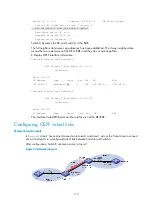
127
Configuring IS-IS
Hardware compatibility
The A5500 SI Switch Series does not support IS-IS.
IS-IS overview
Intermediate System-to-Intermediate System (IS-IS) is a dynamic routing protocol designed by the
International Organization for Standardization (ISO) to operate on the connectionless network protocol
(CLNP).
The IS-IS routing protocol was modified and extended in RFC 1195 by the International Engineer Task
Force (IETF) for application in both TCP/IP and OSI reference models, and the new one is named
"Integrated IS-IS" or "Dual IS-IS".
IS-IS is an Interior Gateway Protocol (IGP) used within an Autonomous System. It adopts the Shortest Path
First (SPF) algorithm for route calculation.
The term "router" in this chapter refers to both routers and Layer 3 switches.
Basic concepts
IS-IS terminology
•
Intermediate system (IS)
—Similar to a router in TCP/IP, it is the basic unit in IS-IS to generate and
propagate routing information. In the following text, an IS refers to a router.
•
End system (ES)
—Refers to a host system in TCP/IP. ISO defines the ES-IS protocol for
communication between an ES and an IS. An ES does not participate in the IS-IS processing.
•
Routing domain (RD)
—A group of ISs exchanges routing information with each other using the
same routing protocol in a routing domain.
•
Area
—A unit in a routing domain. The IS-IS protocol allows a routing domain to be divided into
multiple areas.
•
Link State Database (LSDB)
—All link states in the network forms the LSDB. Each IS has at least one
LSDB. The IS uses the SPF algorithm and LSDB to generate its own routes.
•
Link State Protocol Data Unit (LSPDU) or Link State Packet (LSP)
—Each IS can generate an LSP,
which contains all the link state information of the IS.
•
Network Protocol Data Unit (NPDU)
—A network layer protocol packet in OSI, which is equivalent
to an IP packet in TCP/IP.
•
Designated IS
—On a broadcast network, the designated router is also known as the "designated
IS".
•
Network service access point (NSAP)
—An NSAP is an OSI network layer address. It identifies an
abstract network service access point and describes the network address in the OSI reference
model.
















































